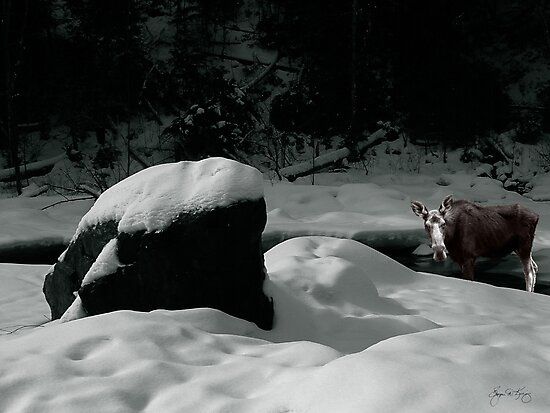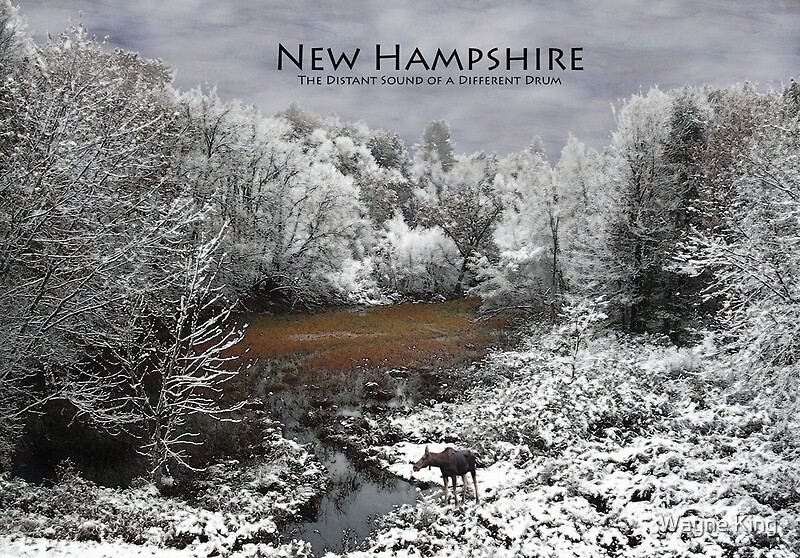| Cattails and Tamarack Under a Painted Sky waynedking.com |
Want an extraordinary foliage experience without the crowds? Try a Tamarack Tour.
We live in one of the most beautiful places on earth. Yet for many of us who live here, it becomes all too commonplace. We find ourselves annoyed by the inconveniences that arise from the flood of visitors to the Granite State during the foliage season. Sure we are often captivated by a favorite tree in foliage or a special place where the changing seasons have a near-spiritual draw for us. . . but all those tourists! All those long waits for a seat at our usual restaurants or jockeying for parking on streets that usually have plenty of open spaces! If you are grateful for anything, it’s probably that the season only lasts for a few weeks.
So, for those who bridle at the crowds of the foliage season in NH and Vermont, but still can find that spark of romanticism that the bittersweet days of autumn can bring to our souls, there is an alternative: Plan a Tamarack Tour.
The Tamarack is also known as the American Larch. Larches are the only coniferous tree that loses its needles in the fall and they do so in a spectacular fashion. In the later weeks of autumn in the Northeast - generally well after the mind-bending colors of the traditional foliage have passed - the Tamarack will begin to turn yellow. Eventually, its needles will fall off, unlike its siblings of the pine, fir, and spruce varieties, but not before presenting its own autumnal display.
If there hasn’t been a windstorm, stripping leaves from the trees, many of the other trees will still have their leaves, but they will have gone to brown, setting up a near-perfect tableau for the colors of the Tamarack, splashing varied hues of yellow across the landscape and mixing with the greens and blues of the conifers and the browns of the deciduous trees.
For the aesthetic, it can be a heart-melting visual experience.
According to the UNH Cooperative Extension: “Tamarack is very intolerant of shade, and is referred to by foresters as a pioneer species. In other words, it is one of the first species to occupy a disturbed site, establishing readily on burns, clearcuts, and abandoned agricultural land, especially those with poorly drained soils. It is commonly seen growing on roadsides, old log landings, field edges, and other places where a significant disturbance created an opening and exposed mineral soil. Tamarack seeds germinate well on mineral soil and on moss, which is why they can become established in peatlands.
Due to tamarack’s affinity for wet sites and its intolerance of shade, it is typically found in association with other species that share similar ecological characteristics. Some common associates in wet organic soils are black spruce and northern white cedar. On sites with slightly better drainage, balsam fir and white spruce are found growing with tamarack. The species is also found in association with quaking aspen, grey birch, and white birch on old field sites, along with alder, willow, and red-osier dogwood in areas of old poorly drained pasture or field.”
Tamarack is an Algonquin word, the ancient root language of both my Paternal grandparents - he of the Iroquois Confederacy and she of the Abenaki nation. The word translates roughly into “wood used for snowshoes”. The wood is flexible yet tough. Native people also used the fine roots of tamarack to sew birch bark for both dwellings and canoes. Other uses of tamarack by native people included dogsled runners, boat gunwales and ribs, and fish traps.
In his extraordinary book “A Sand County Almanac” Aldo Leopold described the color of Tamarack in fall as “smoky gold” but variations in the mineral composition of the soil can yield colors in a broad spectrum of yellow and gold.
Take Your Best Shot:
The best places to see Tamarack are in wet, boreal areas, especially in the North Country and Great North Woods of New Hampshire (where you might get lucky and see a moose or two as well) and the Northeast Kingdom in Vermont. There are also some select areas in Southern NH and the Monadnock region where you will find them, though you may need to enlist the help of a local native to identify those spots (look for the ponds and wetlands).
The image below was captured on the southern end of The Easton Road between Franconia and Rte 112 in Easton, just north of Franconia Notch. I came upon it at a particularly sharp bend in the road, at the end of which a bog revealed itself dusted by the season’s first snow and the bright yellow of its Tamarack. It inspired the poem beneath it, as well as a scene in the book I was writing at the time, "Sacred Trust". Penned later by the warmth of a fire in my beloved home in Rumney, my Alice sitting by my side, filling the draft pages of my novel with the red pen marks of an editor. Laughing just enough to bolster my confidence to continue.
Notes & Links
Recommended scenic roads and hikes on your Tamarack trail.
Bradford Bog: Hike the bog from East Washington Road in Bradford, NH. There is a trail guide and map available online at Bradfordnh.org
The Easton Road, Franconia to Rte 112.
Pondicherry Wildlife Refuge, Whitefield, NH. Pondicherry has often been called one of the “crown jewels” of New Hampshire’s landscape, and visitors to the site will easily understand why. The ponds, wetlands, and forests of this refuge support a wide variety of significant ecological features. Trailhead address: Presidential Rail Trail, 289 Airport Road, Whitefield, NH 03598.
Tripoli Road: Waterville Valley to Rte 93
Hoar Pond: Nussdorfer Nature Area, New Ipswich, NH The area around Hoar Pond is populated with a stand of tamarack. Parking off Old Country Road, which is found from River Road off Route 124. Look for brown and white signs.
Ponemah Bog Trail, Amherst, NH
https://www.nhaudubon.org/lands/sanctuaries/ponemah-bog/
The Fells, Philbrick-Crecenti Bog, Sunapee NH
https://lake-sunapee-living.com/lake-sunapee-hiking-biking/philbrick-cricenti-bog-trail/
Quincy Bog in Rumney, NH lays claim to a champion Tamarack. Founded by the legendary couple Ann and Joe Kent of Rumney, Quincy Bog has a beautiful little trail, just over a mile long skirting the bog with special walkways made from (you guessed it!) Tamarack which is strong and especially impervious to rot.
UNH Cooperative Extension Tamarack Page:
https://extension.unh.edu/blog/2019/12/tamarack
About Wayne D. King: Author, podcaster, artist, activist, social entrepreneur and recovering politician. A three-term State Senator, 1994 Democratic nominee for Governor. His art (WayneDKing.com) is exhibited nationally in galleries and he has published five books of his images, most recently, "New Hampshire - a Love Story”. His novel "Sacred Trust" a vicarious, high voltage adventure to stop a private powerline as well as the photographic books are available at most local bookstores or on Amazon. He lives on the “Narrows” in Bath, NH at the confluence of the Connecticut and Ammonoosuc Rivers and proudly flies the American, Iroquois and Abenaki Flags. His publishing website is: Anamaki.com.
Produced at Anamaki Studios in Bath, NH.
This land lies in N’dakinna, the traditional ancestral homeland of the Abenaki, Sokoki, Koasek, Pemigewasset, Pennacook and Wabanaki Peoples past and present. We acknowledge and honor with gratitude those who have stewarded N’dakinna throughout the generations.









No comments:
Post a Comment